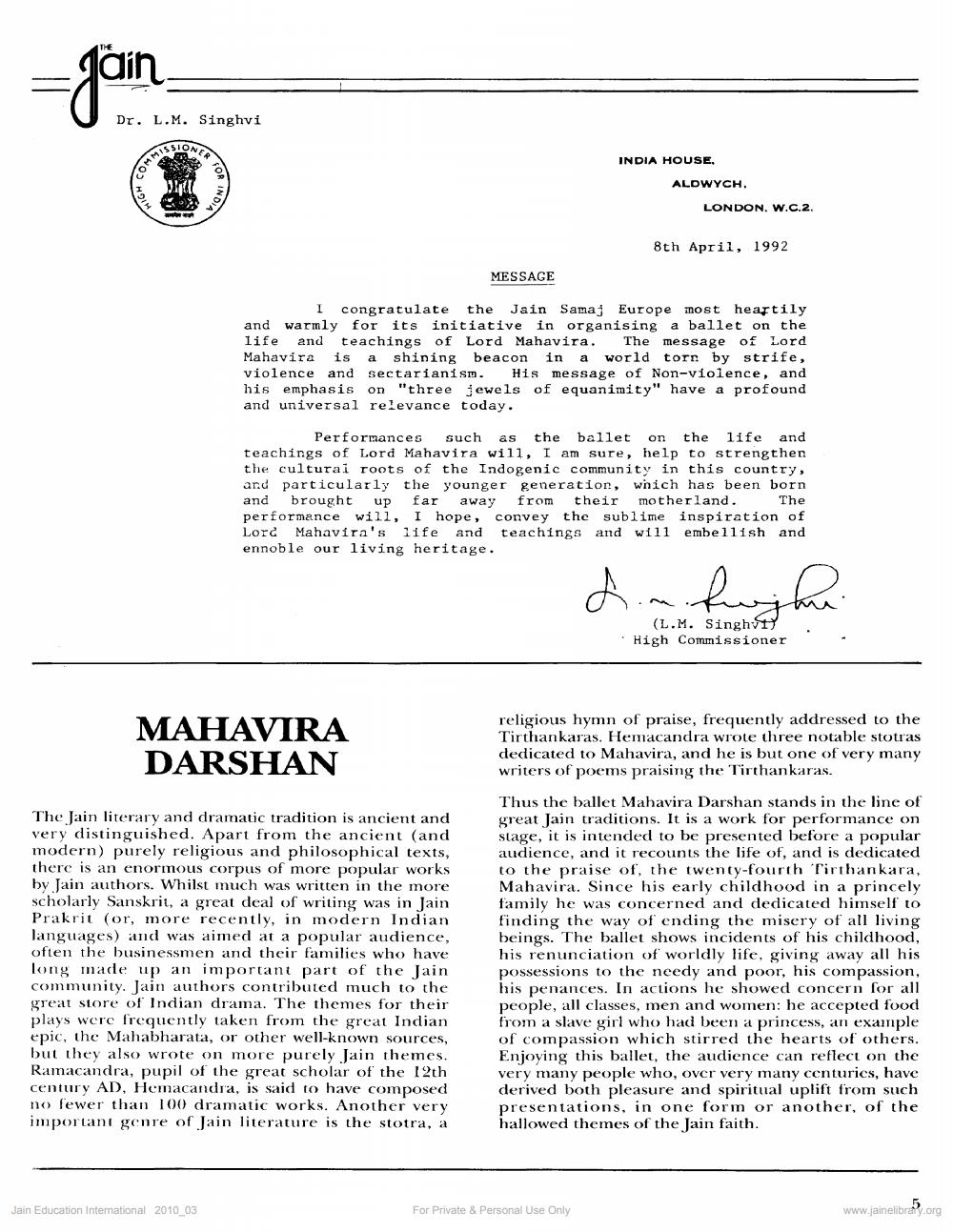Book Title: The Jain 1992 04 Special Issue Author(s): Natubhai Shah, Vinod Kapashi Publisher: UK Jain Samaj Europe View full book textPage 5
________________ =Jain Dr. L.M. Singhvi COMM HIGH MAHAVIRA DARSHAN Jain Education International 2010_03 MESSAGE The Jain literary and dramatic tradition is ancient and very distinguished. Apart from the ancient (and modern) purely religious and philosophical texts, there is an enormous corpus of more popular works by Jain authors. Whilst much was written in the more scholarly Sanskrit, a great deal of writing was in Jain Prakrit (or, more recently, in modern Indian languages) and was aimed at a popular audience, often the businessmen and their families who have long made up an important part of the Jain. community. Jain authors contributed much to the great store of Indian drama. The themes for their plays were frequently taken from the great Indian epic, the Mahabharata, or other well-known sources, but they also wrote on more purely Jain themes. Ramacandra, pupil of the great scholar of the 12th century AD, Hemacandra, is said to have composed no fewer than 100 dramatic works. Another very important genre of Jain literature is the stotra, a INDIA HOUSE. ALDWYCH. I congratulate the Jain Samaj Europe most heartily and warmly for its initiative in organising a ballet on the life and teachings of Lord Mahavira. The message of Lord Mahavira is a shining beacon in a world torn by strife, violence and sectarianism. His message of Non-violence, and his emphasis on "three jewels of equanimity" have a profound and universal relevance today. Performances such as the ballet on the life and teachings of Lord Mahavira will, I am sure, help to strengthen the culturai roots of the Indogenic community in this country, and particularly the younger generation, which has been born and brought up far away from their motherland. The performance will, I hope, convey the sublime inspiration of Lord Mahavira's life and teachings and will embellish and ennoble our living heritage. d LONDON. W.C.2. 8th April, 1992 For Private & Personal Use Only ~ (L.M. Singhvi High Commissioner religious hymn of praise, frequently addressed to the Tirthankaras. Hemacandra wrote three notable stotras dedicated to Mahavira, and he is but one of very many writers of poems praising the Tirthankaras. Thus the ballet Mahavira Darshan stands in the line of great Jain traditions. It is a work for performance on stage, it is intended to be presented before a popular audience, and it recounts the life of, and is dedicated to the praise of, the twenty-fourth Tirthankara, Mahavira. Since his early childhood in a princely family he was concerned and dedicated himself to finding the way of ending the misery of all living beings. The ballet shows incidents of his childhood, his renunciation of worldly life, giving away all his possessions to the needy and poor, his compassion, his penances. In actions he showed concern for all people, all classes, men and women: he accepted food from a slave girl who had been a princess, an example of compassion which stirred the hearts of others. Enjoying this ballet, the audience can reflect on the very many people who, over very many centuries, have derived both pleasure and spiritual uplift from such presentations, in one form or another, of the hallowed themes of the Jain faith. www.jainelibrary.orgPage Navigation
1 ... 3 4 5 6 7 8 9 10 11 12 13 14 15 16 17 18 19 20 21 22 23 24 25 26 27 28 29 30 31 32 33 34 35 36 37 38 39 40 41 42 43 44 45 46 47 48 49 50 51 52 ... 68
